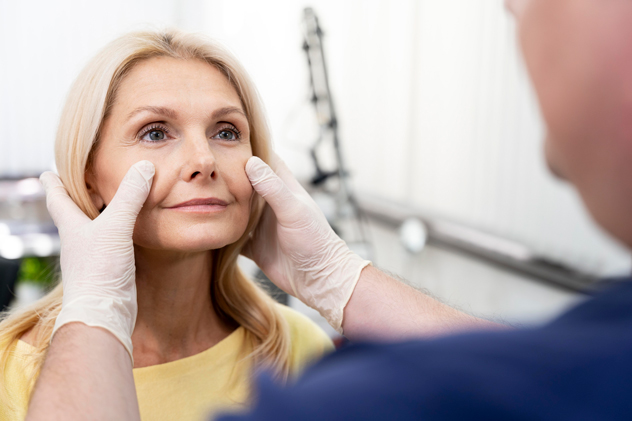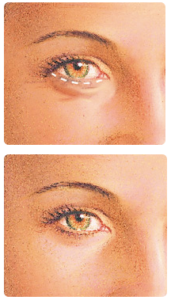Eyelid Surgery in Memphis
Eyelid surgery, called blepharoplasty, is a surgical procedure to improve the appearance of the eyelids. Surgery can be performed on either the upper and lower lids, or both. Whether you want to improve your appearance or are experiencing functional problems with your eyelids, eyelid surgery can rejuvenate the area surrounding your eyes.
Specifically, eyelid surgery can treat:
- Loose or sagging skin that creates folds or disturbs the natural contour of the upper eyelid, sometimes impairing vision
- Excess fatty deposits that appear as puffiness in the eyelids
- Bags under the eyes
- Drooping lower eyelids that reveal white below the iris
- Excess skin and fine wrinkles of the lower eyelid

In general, good candidates for a eyelid surgery include:
- Healthy individuals who do not have a lifethreatening illness or medical conditions that can impair healing
- Non-smokers
- Individuals with a positive outlook and specific goals in mind for eyelid surgery
- Individuals without serious eye conditions
Remember that the eyelids are part of the face. The appearance of a drooping upper lid may also be due to relaxation of the forehead skin and eyebrow. Sometimes a drooping eyelid is caused by stretching of one of the upper eyelid muscles, the levator. Your plastic surgeon will evaluate your anatomy thoroughly to determine the causes of your eyelid appearance, and what procedures might best remedy them.
Consultation and Preparing for Surgery
- Your surgical goals
- Medical conditions, drug allergies, and previous medical treatments and specifically any problems you have had with your eyes
- Current medications, vitamins, herbal supplements, alcohol, tobacco, and drug use
- Previous surgeries
Your surgeon will also:
- Evaluate your general health status and any pre-existing health conditions or risk factors
- Take photographs
- Discuss your eyelid surgery options
- Recommend a course of treatment
- Discuss likely outcomes of eyelid surgery and any potential risks
- Discuss the type of anesthesia that will be used
Prior to surgery, you may be asked to:
- Get lab testing or a medical evaluation
- Take certain medications or adjust your current medications
- Stop smoking
- Avoid taking aspirin, anti-inflammatory drugs, and herbal supplements as they can increase bleeding
Eyelid surgery may be performed in an accredited office-based surgical facility, outpatient or licensed ambulatory surgical center, or a hospital. Be sure to arrange for someone to drive you to and from surgery and to stay with you for at least the first night following surgery.
Be sure to ask questions. It’s very important to ask your plastic surgeon questions about your eyelid surgery. It’s natural to feel some anxiety, whether it’s excitement for your anticipated new look or a bit of preoperative stress. Don’t be shy about discussing these feelings with your plastic surgeon.
The Procedure
The incision lines for eyelid surgery are designed so the resultant scars will be well concealed within the natural structures of the eyelid region.
The upper eyelid can be corrected through an incision within the natural crease on the eyelid. This allows for removal or repositioning of fat deposits, tightening of muscles, and removal of excess skin.
Conditions of the lower eyelid may be corrected with an incision just below the lower lash line. Through this incision, excess skin in the lower eyelid is removed. Again, the excess fat can be repositioned or removed.
A transconjunctival incision, created on the inside of the lower eyelid, is an alternate technique to correct lower eyelid conditions and redistribute or remove excess fat. With this technique, no skin is removed.

- Removable sutures
- Skin adhesives
- Surgical tape


Risks and Safety
The decision to have eyelid surgery is personal, and you’ll have to decide if this surgery will achieve your goals, and if the potential risks are acceptable. Be sure you understand the surgery and recuperation completely, and don’t hesitate to ask your plastic surgeon questions.
The risks include:
- Anesthesia risks
- Swelling and bruising
- Bleeding from the incision lines
- Dryness to the eyes
- Sensitivity to sun or other bright light
- Difficulty closing your eyes
- Ectropion, an outward rolling of the eyelid
- Infection
- Lid lag, a pulling down of the lower eyelid may occur and is often temporary
- Temporary or even permanent change in vision, and very rare chance of blindness
- Changes in skin sensation
- Pain, which may persist
- Poor wound healing
- Possible need for revision surgery
- Unfavorable scarring
These risks and others will be fully discussed prior to your consent. It is important that you address all your questions directly with your plastic surgeon.
Recovery After Surgery
After your procedure is completed, lubricating ointment and cold compresses may be applied, and in some cases your eyes may be loosely covered with gauze.
You will be given specific instructions that may include how to care for your eyes, medications to apply or take orally to aid healing and reduce the potential for infection, specific concerns to look for at the surgical site or in your overall health, and when to follow-up with your plastic surgeon.
Initial healing may include some swelling, bruising, irritation or dry eyes, and discomfort that can be controlled with medication, cold compresses, and ointment. Irritation at the incision sites is also possible.
Be sure to ask your plastic surgeon specific questions about what you can expect during your individual recovery period.
- Where will I be taken after my surgery is complete?
- What medication will I be given or prescribed after surgery?
- Will I have dressings/bandages after surgery?
- When will they be removed?
- Are stitches removed? When?
- When can I resume normal activity and exercise?
- When do I return for follow-up care?
You must practice diligent sun protection and use darkly tinted sunglasses until the healing process is fully complete.
Results
The results of eyelid surgery will be long-lasting. Your final results will appear within several weeks, but it may take up to a year for incision lines to fully refine. While eyelid surgery can be expected to correct certain conditions permanently, you will continue to age naturally. Life-long sun protection will help to maintain your results. Satisfaction with your new image should continue to grow as you recover from surgery. As swelling and bruising subside, the results of eyelid surgery will reveal a smooth, better-defined eyelid and surrounding region and an alert and rejuvenated appearance.
Although good results are expected from your procedure, there is no guarantee. In some situations, it may not be possible to achieve optimal results with a single surgical procedure and another surgery may be necessary.
Following your physician’s instructions is essential to the success of your surgery. It is important that the surgical incisions are not subjected to excessive force, abrasion, or motion during the time of healing. Your doctor will give you specific instructions on how to care for yourself.
Robert Wallace MD
“Dr. Robert D. Wallace has been recognized for many years as one of the best plastic surgeons in the United States and has an international reputation for his work in craniofacial, cleft, and cosmetic surgery. He has been on Castle Connelly’s Top Doc list and Best Doctors award for many consecutive years. In addition, he was selected by Newsweek magazine in 2021 and 2022 as one of the top 100 plastic surgeons in the USA on their list for facelift and rhinoplasty surgery. In 2022 he was honored by Memphis Business Journal with the Healthcare Hero award in the physician category for his work in pediatric and craniofacial surgery. He has published multiple medical articles and book chapters in plastic surgery literature.”

Get In Touch
If you have any questions or want to schedule an appointment, contact us and our team will be glad to support you